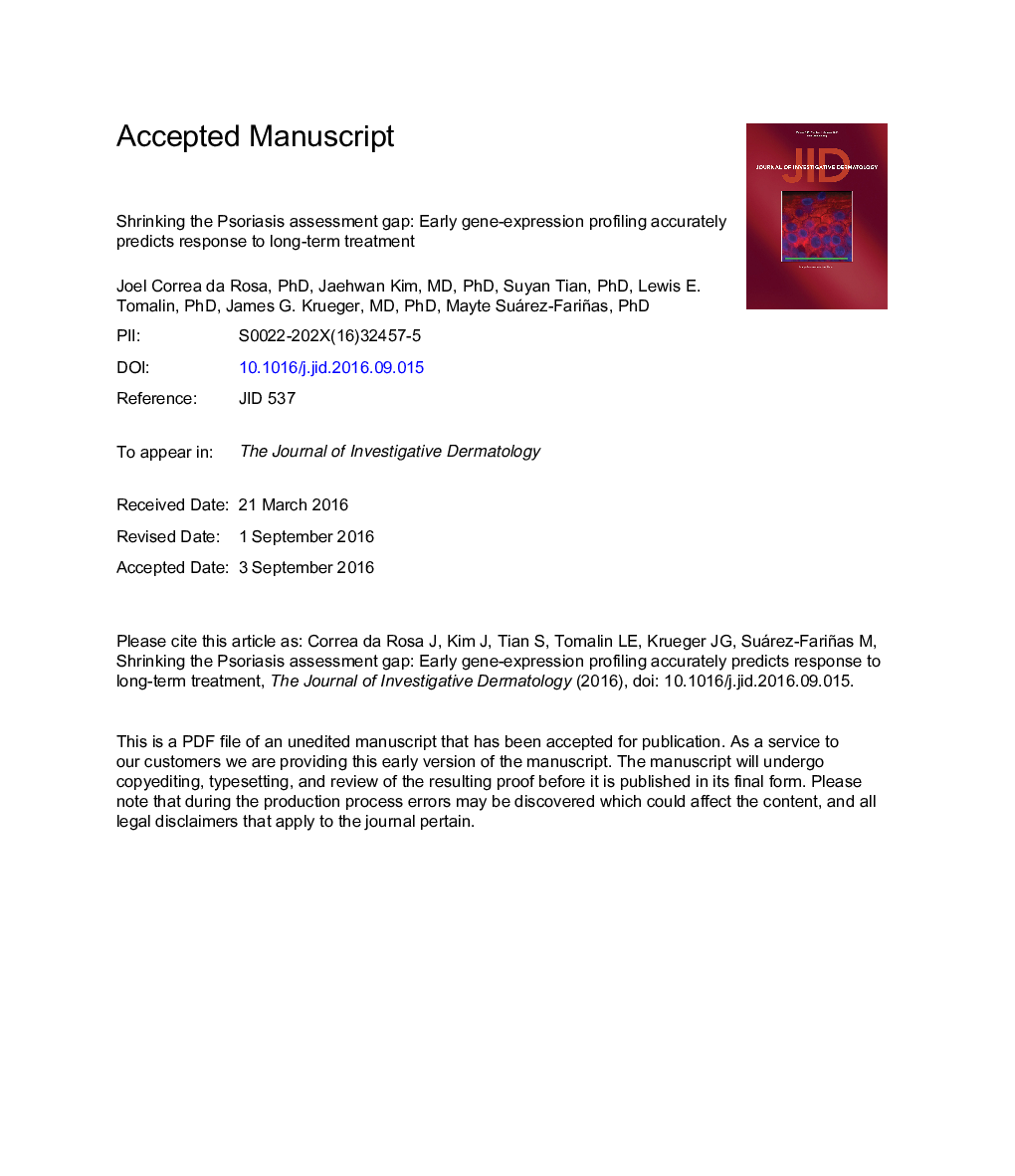| کد مقاله | کد نشریه | سال انتشار | مقاله انگلیسی | نسخه تمام متن |
|---|---|---|---|---|
| 5649778 | 1407131 | 2017 | 27 صفحه PDF | دانلود رایگان |
عنوان انگلیسی مقاله ISI
Shrinking the Psoriasis Assessment Gap: Early Gene-Expression Profiling Accurately Predicts Response to Long-Term Treatment
ترجمه فارسی عنوان
کاهش تدریجی ارزیابی پسوریازیس: پیشگیری از بروز ژن های بیان ژن به طور دقیق پیش بینی پاسخ به درمان طولانی مدت
دانلود مقاله + سفارش ترجمه
دانلود مقاله ISI انگلیسی
رایگان برای ایرانیان
کلمات کلیدی
ترجمه چکیده
یک ارزیابی تقریبی وجود دارد؟ بین لحظه ای که پاسخ بیمار به درمان از نظر زیست شناختی تعیین می شود و زمانی که یک پاسخ واقعا می تواند به صورت بالینی تعیین شود. پروفایل بیوشیمیایی بیمار یکی از عوامل مهم در نتیجه بالینی برای یک درمان خاص است. بنابراین امکان پذیر است که اطلاعات بیمار در سطح مولکولی را می توان برای کاهش شکاف ارزیابی استفاده کرد. با تشکر از نمونه های بیوپسی قابل دسترسی بالینی، اطلاعات مولکولی با کیفیت بالا برای بیماران پسوریازیس به طور گسترده ای در دسترس هستند. بنابراین پسوریازیس یک بیماری عالی برای آزمایش پیش بینی نتایج درمان از داده های مولکولی است. مطالعه ما نشان می دهد که پروفایل ژن های ضایعات پوستی پسوریازیس که در 4 هفته اول درمان گرفته شده است، می تواند به دقت پیش بینی (منطقه 80٪ در زیر منحنی مشخصه عملکرد گیرنده) نقطه پایانی بالینی در 12 هفته باشد. این می تواند شکاف ارزیابی پسوریازیس را تا 2 ماه کاهش دهد. ما دو حالت پیش بینی متمایز را ارائه می دهیم: یک پیش بینی جهانی، با هدف پیش بینی اثربخشی داروهای تست نشده و پیش بینی های خاص پیش بینی شده برای پیش بینی پاسخ بالینی به درمان با چهار دارو خاص: اتانرپت، ماستکینوماب، آدالیمواب و متوترکسات. ما همچنین دو نوع پیش بینی را توسعه می دهیم: یکی از جزئیات دقیق، اطلاعات خاص پلت فرم و یکی از داده های مبتنی بر مسیر مستقل از پلت فرم. ما نشان می دهیم که بیومارکر های کلیدی با پاسخ به داروها و دوزها همراه هستند و در نتیجه بینش زیست شناسی از تغییر پاتوژنز را فراهم می کنند.
موضوعات مرتبط
علوم پزشکی و سلامت
پزشکی و دندانپزشکی
امراض پوستی
چکیده انگلیسی
There is an “assessment gap” between the moment a patient's response to treatment is biologically determined and when a response can actually be determined clinically. Patients' biochemical profiles are a major determinant of clinical outcome for a given treatment. It is therefore feasible that molecular-level patient information could be used to decrease the assessment gap. Thanks to clinically accessible biopsy samples, high-quality molecular data for psoriasis patients are widely available. Psoriasis is therefore an excellent disease for testing the prospect of predicting treatment outcome from molecular data. Our study shows that gene-expression profiles of psoriasis skin lesions, taken in the first 4 weeks of treatment, can be used to accurately predict (>80% area under the receiver operating characteristic curve) the clinical endpoint at 12 weeks. This could decrease the psoriasis assessment gap by 2 months. We present two distinct prediction modes: a universal predictor, aimed at forecasting the efficacy of untested drugs, and specific predictors aimed at forecasting clinical response to treatment with four specific drugs: etanercept, ustekinumab, adalimumab, and methotrexate. We also develop two forms of prediction: one from detailed, platform-specific data and one from platform-independent, pathway-based data. We show that key biomarkers are associated with responses to drugs and doses and thus provide insight into the biology of pathogenesis reversion.
ناشر
Database: Elsevier - ScienceDirect (ساینس دایرکت)
Journal: Journal of Investigative Dermatology - Volume 137, Issue 2, February 2017, Pages 305-312
Journal: Journal of Investigative Dermatology - Volume 137, Issue 2, February 2017, Pages 305-312
نویسندگان
Joel Correa da Rosa, Jaehwan Kim, Suyan Tian, Lewis E. Tomalin, James G. Krueger, Mayte Suárez-Fariñas,
